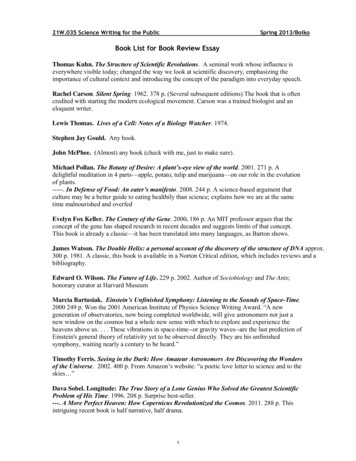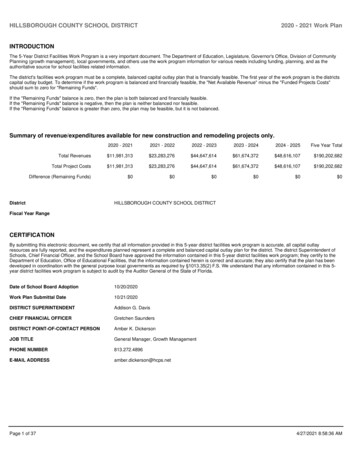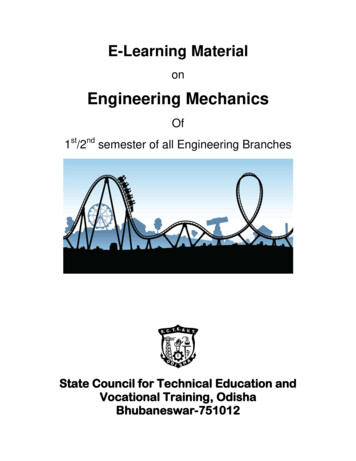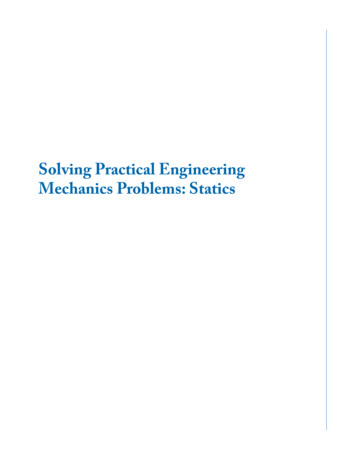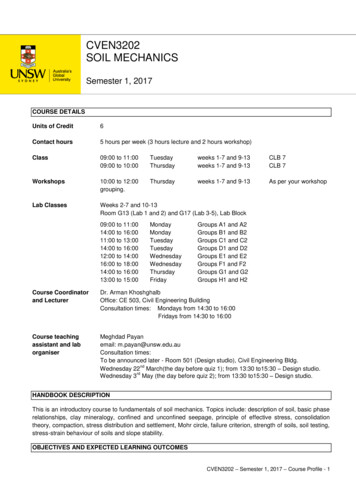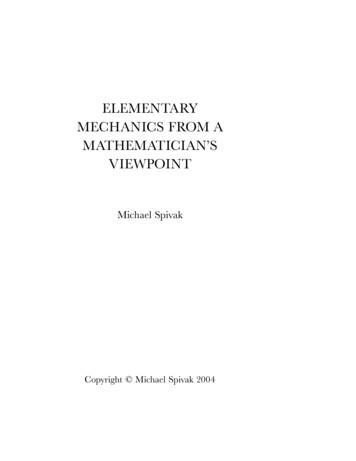
Transcription
ELEMENTARYMECHANICS FROM AMATHEMATICIAN'SVIEWPOINTMichael SpivakCopyright È Michael Spivak 2004
CONTENTSPreface . . . . . . . . . . . . . . . . . . . . . . . . . . . . . . 1Lecture 1. The Hardest Part of Mechanics (The Fundamentals) . . 3Lecture 2. Further Remarks on the Fundamentals . . . . . . . . 25Lecture 3. How Newton Analyzed Planetary Motion . . . . . . 34Lecture 4. Systems of Particles; Conservation Laws . . . . . . . 46Lecture 5. Rigid Bodies . . . . . . . . . . . . . . . . . . . . . 54Lecture 6. Constraints . . . . . . . . . . . . . . . . . . . . . 73Lecture 7. Holonomic and Non-Holonomic Constraints . . . . . 85Lecture 8. Statically Indeterminate Structures . . . . . . . . . . 93References . . . . . . . . . . . . . . . . . . . . . . . . . . . 101
PREFACEIn March of 2004, I had the pleasure of giving eight lectures as part of thePathways Lecture Series in Mathematics, Keiowhich is supported byThe Twenty-ˇrst Century COE Program at KeioIntegrative Mathematical Sciences:Progess in Mathematics Motivated byNatural and Social PhenomenaAs explained in Lecture 1, these lectures cover material that I had just ˇnishedwriting, and which I hope will constitute the ˇrst part of a book on Mechanics forMathematicians. But I tried to present them as course lectures in development,rather than as a ˇnished product, and I beneˇted immensely from this, sincesuch a presentation, and the reactions of the listeners, raised all sorts of questionsthat I hadn't thought of, and which will eventually result in a rather thoroughrewriting of the original material.In these notes, I have tried to preserve the informal nature of these lectures,aiming for spontaneity, rather than the more carefully arrangement of materialone expects to ˇnd in a book, so that they will complement the book (if itever appears) rather than merely serving as a repetition; however, some parts,especially the notes for the later lectures, are taken rather directly from parts ofthe book already written. Though the notes do not reproduce the material ofthe lectures in exactly the same order as they were given, they do cover basicallythe same material.I am grateful to Prof. Yoshiaki Maeda for inviting me to give these lectures,and to Prof. Martin Guest of Tokyo Metropolitan University, where two of theselectures were also given. I greatly enjoyed their hospitality and the experienceof living in Tokyo.1
LECTURE 1THE HARDESTPART OF MECHANICS¡THE FUNDAMENTALS These lectures are based on a book that I am writing, or at least trying towrite. For many years I have been saying that I would like to write a book (orseries of books) called Physics for Mathematicians. Whenever I would tell peoplethat, they would say, Oh good, you're going to explain quantum mechanics, orstring theory, or something like that. And I would say, Well that would be nice,but I can't begin to do that now; ˇrst I have to learn elementary physics, so theˇrst thing I will be writing will be Mechanics for Mathematicians.So then people would say, Ah, so you're going to be writing about symplecticstructures, or something of that sort. And I would have to say, No, I'm nottrying to write a book about mathematics for mathematicians, I'm trying to writea book about physics for mathematicians; of course, symplectic structures willeventually make an appearance, but the problem is that I could easily understand symplectic structures, it's elementary mechanics that I don't understand.Then people would look at me a little strangely, so I'd better explain what Imean. When I say that I don't understand elementary mechanics, I mean, forexample, that I don't understand this:Of course, everyone knows about levers. They are so familiar that most of ushave forgotten how wonderful a lever is, how great a surprise it was when weˇrst saw a small body balancing a much bigger one. Most of us also know thelaw of the lever, but this law is simply a quantitative statement of exactly howamazing the lever is, and doesn't give us a clue as to why it is true, how such asmall force at one end can exert such a great force at the other.Now physicists all agree that Newton's Three Laws are the basis from whichall of mechanics follows, but it you ask for an explanation of the lever in termsof these three laws, you will almost certainly not get a satisfactory answer. Youmight be told something about conservation of angular momentum, or perhapseven the principle of virtual work, but I can almost guarantee that as soon as3
LECTURE 1some one starts to give an answer you can almost certainly interrupt them andexplain why their answer can't be correct. For, the correct answer must beginby saying \First we have to understand rigid bodies", since, after all, the rigidityof the lever is an absolute necessity for it to work, and if one hasn't alreadyanalyzed rigid bodies, then one simply isn't in a position to give an explanationof the lever.Well, we won't get to rigid bodies for a few lectures yet, so it'll be a whilebefore we can give a good answer to this question.In these lectures I am basically going to cover (portions of ) the part of thebook that has been written so far. The ˇnal book will contain 4 parts:I. FundamentalsII. ApplicationsIII. Lagrangian MechanicsIV. Hamiltonian Mechanics,with perhaps a ˇfth part,V. Abstractions to Lie groups.I hope to ˇnish this book in about a year. So far, I have written just Part I,and it has taken me nearly a year and a half,1 but that doesn't mean that myhope is necessarily unrealistic. After all, Part I is the hard part, all about thebasic physical ideas, while the remaining parts are basically mathematics.We are going to be considering the foundations of mechanics by starting rightat the source, Newton's Philosophi Naturalis Principia Mathematica or MathematicalPrinciples of Natural Philosophy, in English, or simply The Principia.Now this book is one of the great classics, probably the greatest book in all ofphysics, but that doesn't mean that some one should try learning physics fromit! Like many a classic, it is basically unreadable. To begin with, it's in Latin,and I don't even think there is a Japanese translation. Fortunately, there is avery good recent English translationNewton, The Principia. Translated by Bernard Cohen and Anne Whitman.and nearly half of this hefty tome is a guide to reading the actual translation;see [N-C-W] in the References at the end of these notes for further details. Anyquotations from the Principia are taken from this book.Newton obviously wrote the Principia with Euclid's Elements in mind. Infact, after the usual beginning stu , the title page, various prefaces for variouseditions, both by Newton and his editor, and a long ode to Newton written byHalley (which I haven't read, but have grave doubts of being very good), thevery ˇrst words of the Principia proper are1 Actuallyabout 2 years, when you count the rewriting that I felt was necessary aftergiving these lectures.4
LECTURE 1DEFINITIONSDeˇnition 1 Quantity of matter is a measure of matter that arises from its density andvolume jointly.Now of course anyone can see that this deˇnition isn't very useful, in factobviously circular, since density is usually deˇned as mass per unit volume. In[N-C-W], and elsewhere, you can ˇnd long discussions about this, but we don'treally need to be concerned. Newton is basically just trying to get started, andhe will tie things together better as he goes along. In fact, this deˇnition isimmediately followed by further discussion:Deˇnition 1 Quantity of matter is a measure of matter that arises from its density andvolume jointly.If the density of air is doubled in a space that is also doubled,there is four times as much air, and there is six times as much ifthe space is tripled. The case is the same for snow and powderscondensed by compression or liquefaction, : : : . Furthermore, Imean this quantity whenever I use the term \body" or \mass" inthe following pages.The three dots here indicate omissions that aren't really very important (you'llhave to take my word for this), but there's also a portion that has been temporarily shaded out. This part, by contrast, is very important, but it's very confusingthat Newton put it right here, and we'll come back to it later!Naturally, these additional remarks don't clarify the concept very much, butat least they help a little, and in particular Newton has now introduced theimportant term \mass" instead of the awkward phrase \quantity of matter". It'ssomething of a distraction that he also uses the word \body", because nowadayswe think of a body as some object, that has a particular mass, so we won't followNewton's usage at all, but will always use the word \mass", whatever in the worldthat is eventually going to mean.The next deˇnition is a lot simpler,5
LECTURE 1Deˇnition 2 Quantity of motion is a measure of motion that arises from the velocity and thequantity of matter jointly.and we merely want to point out that nowadays this is what we call \momentum".The third deˇnition, though just as vague as the others, ˇnally gives us someidea of what \mass" is really supposed to mean.Deˇnition 3 Inherent force of matter is the power of resisting by which every body, so far asit is able, perseveres in its state either of resting or of moving uniformly straightforward.This force is always proportional to the body [i.e., mass] anddoes not di er in any way from the inertia of the mass except inthe manner it which it is conceived. : : :This is certainly a strange way of speaking nowadays, we don't speak of the\force of matter" but, in short, what Newton is saying is that \mass" is basicallywhat we call \inertia", a measure of how hard it is to get something moving. IfI were teaching an introductory mechanics course for physics students I wouldprovide two balls like these [two balls made from styrofoam semi-spheres, identical in appearance], give the ˇrst a slight push, so that it would start rollingrapidly, and then ask a brawny-looking student to repeat this with the second.[The second ball was ˇlled with heavy chain, and barely moved when pusheda great deal harder.] This little experiment shows that the second ball has amuch greater mass than the ˇrst (although the student, if asked, would probably incorrectly conclude that the second ball weighed a lot more than the ˇrst,which is something quite di erent, that we'll get to in a bit).Of course, all of this is merely vaguely descriptive, and the remainder ofthis ˇrst section of the Principia, in which Newton adds a few other deˇnitionsdoesn't help much.So it's time to turn to the second section, the axioms:AXIOMS, OR THE LAWS OF MOTIONLaw 1 Every body perseveres in its state of being at rest or of moving uniformly straightforward, except insofar as it is compelled to change its state by forces impressed.6
LECTURE 1Of course, Newton didn't call this Newton's First Law, and, as we will seelater on, he explicitly credits the law to Galileo. Galileo didn't exactly demonstrate this law, but instead explained why everyday experiences might seem tocontradict it. Not too long ago the law might be illustrated dramatically bysliding an object along a glass table with dry ice evaporating from it, forming acushion of gas that practically eliminates friction. Recently, the invention of the\air-trough" (see reference [N-L]) has provided a nice way to illustrate Newton'sˇrst law in the classroom:One gives the block just the tiniest nudge, and watches it glide at constantvelocity to the end of the track.In an elementary physics course, considerable discussion about coordinatesystems might be required here, but we'll simply point out that we are basicallyassuming that there are certain coordinate systems (\inertial systems") in whichthis law holds, and that any system moving at uniform velocity with respect toan inertial system obviously has the same property. So we pass on immediatelytoLaw 2 A change in motion is proportional to the motive force impressed and takes place alongthe straight line in which that force is impressed.If some force generates any motion, twice the force will generate twicethe motion, : : : .Once again, we have that obnoxious shaded region, which we'll unveil at theappropriate time.Of course, nowadays we simply state the second law asF D ma 7
LECTURE 1where a is the acceleration of our body. Newton speaks in terms of (discrete)\changes in motion" because he often thinks in terms of what we would call\instantaneous" forces, exerted only for a very short time.This law might seem to be virtually meaningless, since we haven't said howto measure mass m nor how to measure force F But there's really more toit than appears, as we will see by skipping to the discussion (\Scholium") thatNewton gives at the end of this section of the Principia, where he begins by acknowledging Galileo (again, some material has been shaded out, to be unveiledat a later date):Scholium The principles I have set forth are accepted by mathematicians andconˇrmed by experiments of many kinds. By means of the ˇrst twolawsGalileo found that the descent of heavybodies is in the squared ratio of the timeas experiment conˇrms, except insofaras these motions are somewhat retarded by the resistance of the air.In the ˇrst and second editions of the Principia, this is all that Newton says,and it might seem rather mysterious what does squared ratio of the time haveto do with the second law? As we will see once again in a future lecture,Newton's exposition often su ered from a defect common to many very brightpeople he often didn't realize that what was obvious to him might not beobvious to others and it was only in the third edition that he added a moredetailed explanation:Scholium The principles I have set forth are accepted by mathematicians andconˇrmed by experiments of many kinds. By means of the ˇrst twolawsGalileo found that the descent of heavybodies is in the squared ratio of the timeas experiment conˇrms, except insofaras these motions are somewhat retarded by the resistance of the air.When a body falls, uniform gravity, by acting equally in individualequal particles of time, impresses equal forces upon that body andgenerates equal velocities; and in the total time it : : : generates atotal velocity proportional to the time. And the spaces described inproportional times are as the velocities and the times jointly, that is,in the squared ratio of the times.Well, this is the sort of explanation that makes you glad that you aren't tryingto learn mathematics in the 17th century! What Newton is saying is the following: Suppose our body starts at rest. The force of gravity, which we think of8
LECTURE 1as an instantaneous force acting at time 0 changes the downward velocity bya small increment v So after a small increment of time t the body has fallenby an amount vt Then its velocity receives an additional increment v givingit velocity 2v so after the next increment t of time it falls by the amount 2vt In the next increment of time it falls by the amount 3vt then by the amount4vt etc. So at the end of a large number N of such increments it has fallen.1 C 2 C 3 C C N / times vt which is close to N 2 vt 2 or to vT 2 2 where Tis the total time it has fallen. Nowadays, of course, we just say, If s 00 D a for aconstant a then s 0 D at and thus s D 12 at 2 Even after all this explanation, you might wonder what this has to do withthe second law, since it seems to be a purely mathematical result about secondderivatives. So it's important to go back and look at one particular phrase inNewton's argument:When a body falls, uniform gravity, by acting : : :What does Newton mean here by \uniform gravity"? You might think he meansthat gravity produces the same acceleration on the body no matter what velocityit already has (and this is indeed one of the things he is assuming), but Newtonis also appealing (implicitly, it is true) to an important fact that we can testexperimentally.To perform this experiment, we are going to use the following apparatus.Now as soon as you see this large spring, you might be thinking: oh, we'regoing to invoke Hooke's law. But we aren't going to be using anything of thesort; notice that's no scale here behind the spring, only a blank piece of wood.We only care about one thing: experience shows us that it takes a greater forceto stretch a string by a large amount than is required to stretch it by a smallamount we are completely uninterested in the particular law involved (whichwe could investigate later, if we ever ˇgured out how to measure force).For the ˇrst part of the experiment, we attach a block to our spring, and usethis nice felt pen to mark on the wood how far down the spring has been pulled.9
LECTURE 1Of course, this isn't a high-tech experiment, it's a Tokyu Hands experiment.1But we could easily imagine a much more reˇned experiment, with a very strongspring, very accurate ways of measuring its displacement, etc.For the sake of time, I'll simply describe the second part of the experiment,instead of having us actually perform it. For this part of the experiment, wewould all go upstairs to the room above this one. Perhaps there's some onethere now, well, we'll just ask them if we can take a moment's time to performa simple experiment. And this simple experiment is a repeat of the experimentthat we have just done here: we attach the block to our spring, and see far downthe spring has been pulled. It appears that the spring has been pulled downexactly the same amount. (At least within the accuracy of our Tokyu Handsexperiment.)The next part of the experiment is one that probably no one except a touristlike myself might be willing to perform, taking the same measurement at thetop of Tokyo Tower. Once again, it seems that the spring is stretched by exactlythe same amount.Now this is what Newton means when he speaks of \uniform gravity": a forcethat is the same no matter how high up we go (of course, that's not really truefor the force of gravity, but it's true to a very good approximation for the sortof distances above the earth's surface that we are concerned with). The pointis that we can at least say when two forces are equal without having to specify away of measuring them.Thus, the experimental evidence that the force of gravity is equal at all reasonable distances from the earth's surface is consistent with the equality ofacceleration along the path of a falling object, which is essentially equivalent toGalileo's observation that \the descent of heavy bodies is in the squared ratioof the time".It may seem a long way from \equal forces produce equal accelerations" to\force equal mass times acceleration", but that's mainly because we still haven'tgiven an \operational deˇnition" of mass, describing how it is to measured. Theimportant point is that the results of our little experiment actually suggest a wayof producing such an operational deˇnition.We'll begin with a deˇnition that is conceptually very straightforward, although it would be rather awkward to use in practice.First we want to have a very long air-trough, with a carriage, of negligiblemass, in which we can place a body whose mass we want to measure. Parallelto this air-trough we have a track with a little cart that can be pulled along thetrack with any desired acceleration a; for simplicity, let's imagine that we merelyhave to turn a knob on an instrument panel to vary a without worrying aboutthe clever mechanism that would be required to produce this e ect. Of course,1 TokyuHands is a large do-it-yourself and hobby store where all the paraphernalia forthis lecture was purchased.10
LECTURE 1our track, and the air-trough, will also have to be very long if we expect to pullthe cart with constant acceleration a for any reasonable amount of time.The cart is provided with an extending arm that can be placed behind thecarriage on the air-trough so that the carriage is moved in tandem with the cart.But instead of placing this arm directly behind the carriage, we will put a nicestrong spring between them.Now let's choose a particular body B0 that we want to be our \unit mass",so that we will assign it mass m D 1 We place this body in the carriage andpull our cart with some convenient constant acceleration a0 Initially, of course,the carriage will not move with the same acceleration, because the spring willcompress somewhat, so that the carriage won't move exactly in tandem withthe cart. But we very quickly reach the point where the spring is no longercompressing, or at any rate the length of the spring is constant within the limitsof accuracy of our measurements. We carefully measure this ˇnal length, andcall it L0 Note, by the way, that this whole set-up is dependent on our original experimentalobservation that equal forces produce equal acceleration: the compression of thespring measures the force that is being applied to the carriage, and once thecarriage is moving with a constant acceleration, the force applied to it must beconstant.Now let's take some other body B whose mass m we want to determine.We place B in the carriage instead of B0 and once again pull our cart withconstant acceleration a0 and observe the (ˇnal) length of the compressed spring.It probably isn't L0 any more, so we try adjusting the acceleration a in orderto make it become L0 : if the spring was compressed more, to a length L0 we try an acceleration a0 if it was compressed to a length L0 we try anacceleration a0 After lots of trial and error, we ˇnally ˇnd an accelerationa1 which compresses the spring to exactly the length L0 We now deˇnemass m of B Da0:a1This deˇnition makes the law F D ma work for any particular ˇxed F andmuch experimentation would show that it works just as well for any other F; inother words, if we repeated this whole process using a di erent spring, and thusa di erent L0 we would still end up assigning the same masses to all bodies.11
LECTURE 1Then, of course, we can use the equation in reverse, as a way of measuring force,by seeing what acceleration is produced on a body of some known mass m Before proceeding further, two points should be made. First, our original littleexperiment is certainly consistent with F D ma but it would hardly seem to bevery conclusive. After all, how do we know that the correct law isn't somethinglike F D ma C ka0 for some constant k so that third derivatives, or even higherderivatives, are involved? I don't know of any experiments to directly test this,but of course there is an enormous body of experience that attests to it: theforce of gravity isn't constant over large distances, so all the calculations thatkeep satellites in motion, guide space ships to the moon and land them, etc.,present a great deal of evidence.A second point to ponder is that we always take for granted that mass is\additive": if we take bodies of mass m1 and m2 and join them together (forexample, by placing them together in the carriage on our air-trough), then thenew object should have mass m1 C m2 In terms of our operational deˇnition,this hardly seems clear: it says that if a1 is the acceleration that the ˇrst bodymust be subjected to in order to compress the spring to length L0 while a2 isthe acceleration that the second body must be subjected to in order to compressthe string the same amount, then to obtain the same compression for the twoobjects together, they must be subject to an acceleration a satisfying1aD1a1C1a2to obtain the same compression. At ˇrst glance, this might seem to be a strangefact that could only be veriˇed by experiments with large numbers of varyingmasses, so it is interesting to try to ˇgure out what reasonable body of basicexperimental facts would lead one to the additivity of mass in a more reasonablemanner, an exercise you might like to think about before the next lecture.Finally, here is a less direct, but more convenient operational deˇnition ofmass, based on the mathematician's and physicist's common view that a straightline is just a circle of inˇnite radius.Instead of using an air-trough, we simply attach our body B to the end ofa very sti spring that is being rotated horizontally with some large constant\angular frequency" so that B moves along the circlec.t/ D R.cos t; sin t/for some radius R This radius R will be somewhat larger than the unstretchedlength of the spring, because B actually begins moving along a spiral, pullingthe spring out, though its path soon becomes indistinguishable from a circle.For the acceleration we simply have(A)c 00 .t/ D R 2 .cos t; sin t/ 12
LECTURE 1so that the acceleration always points directly inward, and has magnitude R 2 This means that the force F that the spring exerts on B also always pointsdirectly inward and has constant magnitude.Declaring B to be our unit of mass amounts to saying that(a)jFj D 1 R 2 :To determine the mass m of any other body, we attach it to the end of ourspring and vary the angular frequency with which we rotate it until we arriveat an angular frequency ˇ for which our body is moving along a circlec.t/ D R.cos ˇt; sin ˇt/of the same radius R Now we should have(b)jFj D m Rˇ 2 with the jFj in equations (a) and (b) having the same value, since in both casesthe spring has been stretched by the same amount. In other words, we candetermine m bym D 2 ˇ 2 :We've ignored the e ect of gravity on these bodies, but that would becomenegligible in comparison to the force of our sti spring when is large, or wemight imagine the measurements being made in outer space.I'm sure that the basic mechanism for this deˇnition could be greatly reˇned.Instead of a spring, one might whirl a tube ˇlled with mercury, and measurethe compression of this mercury column, etc. But I don't think any one hasever actually produced a mechanism of this sort. In fact, as far as I know, noone has ever measured the mass of anything accurately. This statement obviouslyrequires a bit of explanation!Let's consider these two balls, which we used previously in a little \experiment" to illustrate the concept of mass, and again enlist the aid of the studentwho performed the experiment, and quite possibly stated, incorrectly, that theexperiment showed that the second ball had a greater weight than the ˇrst(rather than a greater mass). We could then continue the experiment by takingeach of the balls o the table, in turn, and having the student hold it. Almostno e ort would be required to hold up the ˇrst ball [as you can see when Ihold it up], while considerably more e ort would be required for the secondball [as you can now see me straining a bit to hold up the second ball]. Thissecond experiment shows that the weight of the second ball a measure of thegravitational force exerted on it by the earth is much greater than the weightof the ˇrst.In the ˇrst experiment, the e ect of this gravitational force was irrelevant(except insofar as it a ected friction), because the table was counteracting this13
LECTURE 1force, so we were simply comparing the mass of the two bodies, while the second experiment directly compares the weight of the two bodies. So one of theˇrst things that every beginning physics student needs to learn is the di erencebetween mass and weight. For modern students, it's probably especially easy toillustrate this di erence by considering what happens in a freely moving spacecraft where everything has no weight at all, so that these two balls would simplyoat where ever they were placed, but where moving one of the balls would be alot more diıcult than moving the other.On the other hand, once we've clariˇed this distinction, we have to confusethe students once again, by pointing out that the relative masses of two bodiesseem to be the same as their relative weights everyday experience would certain have led us to conclude, without even thinking about it, that the secondball, so much harder to set in motion, would also be much harder to lift.In terms of the second law, we can make a much more speciˇc correlation:Since the weight of an object, of mass m say, is the force F of gravity on it,the law F D m v0 means that the ratio F m of weight to mass is simply theacceleration that an object undergoes under free fall. Thus, proportionality ofweight to mass is equivalent to the assertion that all bodies fall with the sameacceleration, the famous fact usually attributed to Galileo.Aristotle, as we all know, had claimed that large bodies fall faster than smallerones, and people apparently believed this for many centuries afterward, butit never made much sense. Even before Galileo's experiment, a man namedJ.-B. Benedetti (1530-1590) had pointed out how absurd this would be (see [M],Chapter II, section I, 2). After all, suppose we drop a brick like this one [luckily,it was a fake brick, so it didn't hurt the oor], and then take two of these bricks,tape them together, and drop them side by side: why in the world would thetwo bricks fall faster than each individual brick? But Benedetti still thoughtthat denser bodies would fall more rapidly than less dense ones, and Galileois usually credited with being the ˇrst to realize that even bodies with di eringcompositions, like wood and iron, fall at the same rate. Modern physicists wouldchoose something like aluminum and gold, which have such di erent ratios ofprotons and neutrons, because, after all, we're really saying that everything, eveneach of the elementary particles, falls at the same rate!Newton, of course, would never had made Aristotle's ˇrst mistake, and certainly realized that it was a question of whether bodies of di ering compositionsfall at the same rate. Although Galileo had performed experiments to determine this, Newton wanted much more accurate results, and he informs us ofthis right at the beginning of the Principia.Recall that the Principia begins with a deˇnition that we previously showedwith some material blocked
a book about physics for mathematicians; of course, symplectic structures will eventually make an appearance, but the problem is that I could easily under-stand symplectic structures, it's elementary mechanics that I don't understand. Then people would look at me a little strangely, so I'd better explain what I


